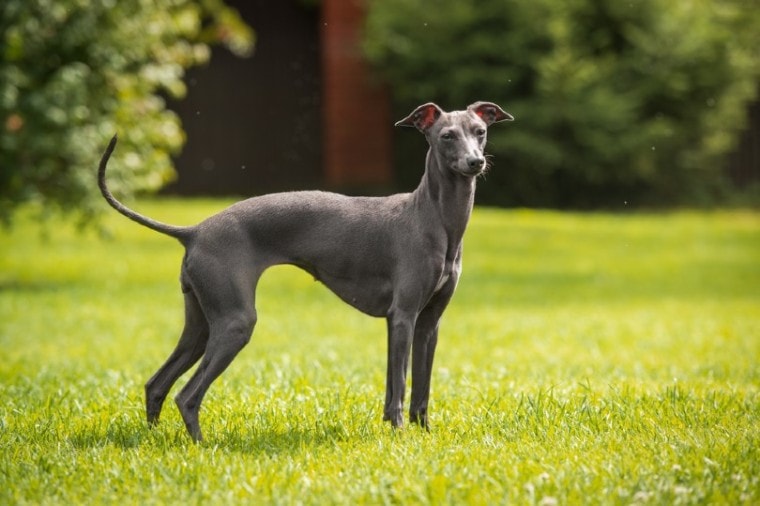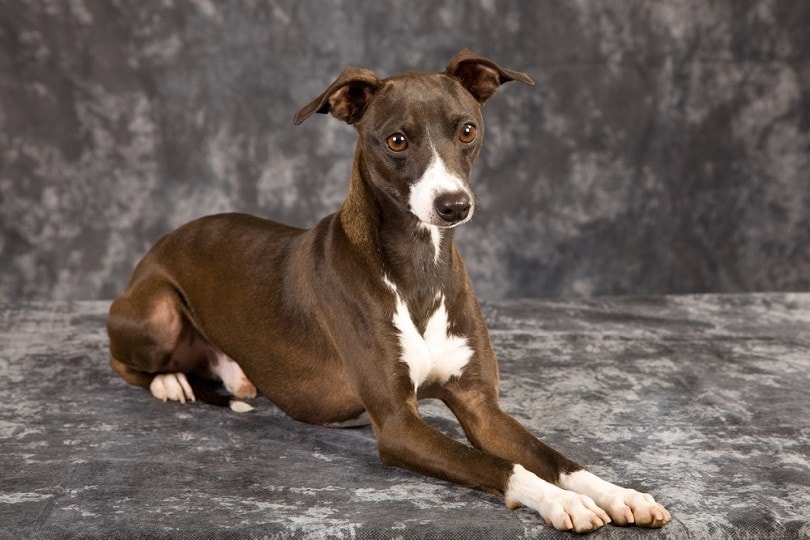
Click Below to Skip Ahead
The Italian Greyhound is a miniature version of a Greyhound in nearly all ways. The smallest of the sighthounds, Italian Greyhounds have a high prey drive and are ready to bolt after small animals if given the chance. Their long legs and slender bodies contribute to their agility and speed. These dogs are low maintenance and easy to care for. They can live happily in an apartment due to their size. They are loyal companion animals that can make friends with children and other resident animals in the home.
Breed Overview
Height:
13 – 15 inches
Weight:
7 – 14 pounds
Lifespan:
12 – 15 years
Colors:
White, fawn, red, black, seal, cream, blue, sable
Suitable for:
Active people, seniors, families with children, those who want an affectionate companion
Temperament:
Affectionate, loving, gentle, energetic, stubborn
Since they are such social dogs and crave the company of their families, they tend to get anxious if left alone for long periods. Separation anxiety is common with Italian Greyhounds, and they benefit well from kennel training or living with another dog to provide company. Positive reinforcement works best with them during any sort of training session. Italian Greyhounds are emotionally sensitive and don’t like harsh tones. This trait, combined with a stubborn streak, can cause your Italian Greyhound to ignore commands and stop engaging in training altogether. Overall, the Italian Greyhound demands very little to be healthy and happy, making this dog ideal for first-time dog owners.
Italian Greyhound Characteristics
Italian Greyhound Puppies
Italian Greyhound rescues or local animal rescues and shelters can sometimes wind up with litters of puppies.
If you are looking for an affectionate companion, you may find that the loving Italian Greyhound is the pup for you. They are also gentle so they will suit a family with children.
Temperament & Intelligence of the Italian Greyhound
Are These Dogs Good for Families? 👪
Italian Greyhounds make affectionate and loving family companions. These dogs love being around people. Spending time curled up on the couch with their owners is something that they love to do. Italian Greyhounds are gentle with children too, but they may not be best for very small toddlers. This breed has long, fragile legs that can be easily broken. A small child falling on the dog accidentally could cause an injury to the dog. The same goes for older children who are rough with the dog.
Does This Breed Get Along With Other Pets?
Italian Greyhounds get along well with other pets in the house provided that they aren’t viewed as prey animals by these dogs, which have high prey drives. An Italian Greyhound sharing living space with a rabbit, hamster, guinea pig, ferret, etc. could mean disaster. With other dogs and cats, the Italian Greyhound can get along well and enjoy being part of a family. The best chance of all the animals living happily together is if the Italian Greyhound is introduced to the family as a puppy. This dog is always best with other animals if they grow up together.
Things to Know When Owning an Italian Greyhound
Food & Diet Requirements 🦴
A well-balanced kibble will be sufficient for an Italian Greyhound. This breed is prone to stomach sensitivity1, either due to food allergies or stress. Grain-free foods can help limit their digestive distress.
Feeding an Italian Greyhound only the recommended amount of food is important. Any added weight on this dog puts unnecessary strain on their already fragile spine and legs. Overweight Italian Greyhounds are at risk for health problems and injuries.
Exercise 🐕
Since Italian Greyhounds have been used as racing dogs, we know that they can run fast. They enjoy running, requiring 1–2 hours of active playtime each day. Running, playing, or even a brisk hike will keep these dogs happy and healthy. They also prefer a good nap in between in each exercise session. Sometimes, they will get sudden bursts of energy and run through the house. Regular play times will help them burn off that energy.
Training 🎾
Italian Greyhounds are intelligent and can learn just about anything that you want to teach them. They also have stubborn streaks, and if they decide that they no longer are interested in training, they will stop engaging. If this happens, it is best to stop and wait for the dog to be ready to engage again. If they are no longer interested, they won’t learn anything. This breed responds best to positive reinforcement and treat rewards for good behavior.
Grooming ✂️
Italian Greyhounds shed, but they have short coats that don’t require much maintenance. Regular nail trims are required to keep the dog’s paws healthy. Brushing their teeth can help keep health conditions, such as periodontal disease, from developing. Brushing their coats a few times a week helps decrease shedding and keeps their coats healthy. A bath once a month will keep them clean and their skin conditioned and soft.
Health and Conditions 🏥
Minor Conditions
Serious Conditions
Male vs. Female
Whether you get a male or female Italian Greyhound is a matter of personal preference. Males are said to be more affectionate and playful than females. Females have a reputation of being independent and wanting to be the boss. While both males and females show resistance to housebreaking, males have been said to be easier to house train and are quicker to learn. Regardless of which you choose, the Italian Greyhound will be a loving pet and companion.
3 Little-Known Facts About the Italian Greyhound
1. The Italian Greyhound was loved in Italy.
Italian Greyhounds were bred as companion dogs 2,000 years ago in Greece and Turkey, but owning miniature dogs became popular in Italy during the Renaissance. Miniature dogs were regarded as status symbols among the wealthy. The breed was given the name Italian Greyhound in Italy in the 16th century.
2. They’re exceptional hunters.
Though small in stature, Italian Greyhounds make efficient hunters. While other hunting breeds rely on their keen senses of smell to find prey, Italian Greyhounds use their vision. They hunt by sight, easily detecting a prey animal’s movements. The dogs then use their speed and agility to quickly find them.
3. This is a watchdog, but not a guard dog.
All bark and rarely any bite, the Italian Greyhound is quick to detect and alert you to noises. Whether it is a car pulling into the driveway or people walking by the house, they’ll let you know about it. While they’re happy to let you know that something is occurring, they’re not strong guard dogs. The barking can turn into fear and shyness. They’ll bark when someone enters the house but then run away from that person once they’re inside.

Final Thoughts
As a gentle and loving dog, the Italian Greyhound is a good choice for those looking for a companion animal for themselves or their families. This dog gets along with children and other animals and is a low-maintenance animal, requiring minimal grooming. They are shy and timid around strangers and can sometimes take a while to warm up. They make loyal watchdogs, always on high alert and ready to let you know if something is happening. With the proper amount of exercise each day, they will remain healthy and happy, burning off excess energy and then being ready to cuddle up for a snooze. Watch this dog around young or rambunctious children because the Italian Greyhound is fragile and easily injured. By providing the care that they need, your Italian Greyhound can live a long and happy life.
Next on your reading list:
- Italian Greagle (Italian Greyhound & Beagle Mix)
- Italian Greyhuahua (Italian Greyhound & Chihuahua Mix)
Featured Image Credit: Alexandra Morrison Photo, Shutterstock








